
jpeters3
-
Posts
736 -
Joined
-
Last visited
Content Type
Profiles
Blogs
Forums
American Weather
Media Demo
Store
Gallery
Posts posted by jpeters3
-
-
9 minutes ago, ATDoel said:
This is probably a dumb question, but it looks like the lack of cap, forecasted for this event, also caused a lot of the junk convection last week, which prohibited super cells from really getting started and why we "only" had 20 something odd EF2s and weaker tornadoes.
Unless I'm mistaken, this forecast has higher amounts of shear, moisture, cape, etc. Even if we get a bunch of junk convection again this go around, is it not fairly logical to think that there's a good chance we have a similar outbreak as last week except, well, with more and stronger... everything?
I think it's reasonable to assume that we'll see something *at least on par with* last week in terms of # of tornadoes and coverage. It's hard to imagine that not happening given the more impressive parameter space.
So what we all are unsure of is whether it will get even worse than last week's bar.
For the record, last week actually had quite a few discrete supercells. They just didn't consistently produce long track tornadoes.-
 3
3
-
 3
3
-
-
6 minutes ago, CheeselandSkies said:
@Fred Gossage just made a great point on another forum, which is that on the 18Z HRRR, you can watch the "junk" updrafts die out with time as the supercells mature and are able to dominate the environment. It was not portraying this evolution leading up to last Wednesday.
I wouldn't lend much credence into these small details. 3 km models cannot properly resolve supercells, much less smaller nonsupercellular updrafts. For reference, supercell updrafts are typically 5-10 km across. Nonsupercells are 1-2 km across.
So what the model is portraying on the convective scale is a bastardization of the real atmosphere.
-
 3
3
-
 1
1
-
-
2 minutes ago, ATDoel said:
JPeters earlier mentioned a pocket of warm dry air at around 850mb inhibiting convective growth, looks like it's still there on the 18z.
This is my guess as to why the NAM nest has less warm sector convection. The warm air does not directly cap things, but could hinder storm growth through entrainment. It's just a guess though.
-
1 minute ago, jojo762 said:
I dunno. Sure seems like there’s plenty of model agreement.
SREF pops a large area of 75% or higher on the significant tornado ingredients combo prob.
The 12z HREF also pops 70% or higher probabilities of UH >75 m2/s2 over parts of Mississippi and Alabama tomorrow.
I get everyone is gun shy because of *gasp* junkvection in Dixie, but it’s really just a reality of setups down there. Albeit, I certainly agree that the lack of CINH (and resulting potential for many more storms) is at least a slight concern for tomorrow reaching its max potential.
Quincy, as always, outlined potential scenarios for tomorrow quite well. If last Wednesday was a *verified high risk*, and a copy of last week is probably the lower-end of possibilities with tomorrow then... you get the rest.
I generally agree that a High risk for tornadoes will probably verify tomorrow. It's almost guaranteed, barring some crazy guidance shift, that tomorrow will have a day 1 high. So the question is, how much worse does it get. As last week showed us, the bar, in terms of tornado outbreaks, is pretty low for a high risk to verify. It can get MUCH MUCH worse.
-
 1
1
-
-
11 minutes ago, forkyfork said:
there isn't much low level cape even on the hrrr
2 minutes ago, forkyfork said:on that second sounding peters posted the juicy cape doesn't start until around 700mb
The tropical tidbits soundings are misleading, because they plot parcel and environmental Temperature, rather than Virtual temperature. If they plotted virtual temperature, the low-level CAPE would show up better.
For those of you who are unfamiliar with virtual temperature, it is a temperature adjustment to the air that accounts for the affect of moisture on density. Virtual temperature is typically a few C warmer than actual temperature when there is a lot of moisture. And sometimes Virtual temperature of a parcel can be larger than that of the environment, despite the parcel's actual temperature being cooler than that of the environment.
-
 1
1
-
-
Here's an example:
Now the MLCIN differences are basically negligible. However, CIN isn't the entire story. Growing updrafts (i.e., congestus) are very susceptible to the negative effects of entrainment. The dry warm region in the Nam NEST at 850 mb may kill everything that tries to form via dry air entrainment. In contrast, the HRRR shows a much deeper moister layer. In the HRRR situation, growing cumulus can make it deeper, and parcels can gain more momentum, before they start to feel the negative effects of entrainment. This difference is subtle, but these types of subtle differences can make or break an outbreak.
-
 5
5
-
 2
2
-
-
2 minutes ago, ATDoel said:
from my inferior knowledge, it seems that there's a sweet spot in the amount of cap present to lead to a significant outbreak. You want some to suppress all the garbage convection but not too much to suppress it all. What exactly are you looking for in the models that give you an idea of what that cap is going to be and where in that "sweet spot" it falls?
This is generally true.
And it's fairly simple. Look at the suite of CAMs, and compare the ones that show development to the ones that don't.
-
Just now, Quincy said:
I’d say the range of scenarios start at being similar to last Wednesday and that’s hoping either it’s a convective mess or there is some sort of cap that tempers the warm sector... and higher end being a generational event. Hard to envision an evolution without at least a couple of intense, long track tornadic supercells. The wind profiles and lapse rates alone also suggest a much greater large hail threat than we saw last week.
Yeah, this pretty well sums it up. If I had to bullshit, i'd say:
20% total bust, with fewer tornadoes than last week60% an outbreak, with at least a few EF3 (+) destructive tornadoes
10% Historic outbreak of the magnitude of 4-12-20, super tuesday, 4-14-12, etc
10% Superoutbreak.
Please keep in mind that these numbers are totally pulled out of my ass.
-
 9
9
-
-
Just now, olafminesaw said:
I think statistical analysis is an underutilized tool in meteorology. In any case of extreme weather, the distribution is skewed right. I figure in setups like these the distribution drops off to the right side of the curve very quickly because of how fragile they are. Extreme environments have a very narrow envelope of CIN, or they fail spectacularly, one what or the other
Agreed. I suspect that if we did an exhaustive analysis of all the CAM solutions that showed apocalypse like this HRRR run, we'd find that 20% or less of them verified as advertised. Not saying we won't have tornadoes tomorrow, but the chances of an actual super outbreak (or even a sub-super, but historic outbreak) remain relatively small.
-
 1
1
-
-
1 minute ago, ATDoel said:
which scenario are you leaning towards?
I honestly don't know. It's basically a coin toss. Lets see how CAM outcomes play out throughout the rest of the day.
My gut tells me that prolific tornado outbreaks are always going to be less likely than a "bust" with this kind of spread in CAM solutions, because there are many pathways to a bust and few to a prolific outbreak.-
 5
5
-
-
5 minutes ago, jojo762 said:
NAM NEST is much more toned down than the HRRR was. In fact it basically shows zero intense convection across most of the MDT risk area during its run. Not gonna buy that.
Careful, this is starting to sound like 5-19-19 all over again, with the HRRR showing apocalypse and the NAM nest showing a seemingly unbelievable non-outbreak. The model isn't violating the laws of physics - it is showing us a dynamically consistently possibility. In examining some soundings, it looks like there is more warming at ~ 850 hPa in the nam nest that acts as a CAP in the warm sector. Again, eerily similar to the "bust" mechanism on 5-20-19. Obviously these two events are quite synoptically different, but we want to learn a lesson from that event and be careful to too hastily throw away CAM solutions that don't show the apocalypse.
Edit: In a probabilistic sense, we've seen the NAM nest solution play out numerous times over the past decades. The HRRR solution, on the other hand, has played out only once (or maybe a handfull of times).-
 4
4
-
-
-
-
One thing to note (as was mentioned by @Bob's Burgers), the 00 UTC HRRR run extends the outbreak well up into the MS and OH river valleys. This HRRR run is fairly close to a worst-case super-outbreak esq scenario. However, I am still somewhat skeptical of storm mode throughout the main warm sector in MS/AL, despite the HRRR showing apocalypse. There may be hints in this solution of an ambient messy storm mode, and an upscale evolution akin to 4-12-20.
Freaky CAM solutions aside, I still highly doubt a day 2 High will happen, nor do I think it is warranted.
Edit: NAM nest shows a similar scenario for MS/AL, and also extends the outbreak a bit further north (albeit not to the extent of the HRRR). One thing to note is both models show fairly quick stabilization into the early morning on Friday, suggesting that a prolific nocturnal event is questionable.-
 1
1
-
-
2 hours ago, JasonOH said:
There’s a lack of an EML which is usually a sign for me of messy storm mode when it comes to Dixie. Don’t expect a D2 high.
This ^^^^^
In general, I don't think issuing day 2 High risks is a good idea. Especially in the SEUS where there is always the inherent uncertainty regarding storm mode. So I would argue that a a day 2 High would be an irresponsible move.Obviously the ceiling on this event is very high. But there is still bust potential, as we have seen in the past with numerous would-be SEUS events. Parameter space is never the entire story.
-
 2
2
-
-
4 minutes ago, CryHavoc said:
It doesn't require any EF4/EF5s to verify high risk, if the NWS wording for high risk is to be followed. High risk specifically indicates a strong (60%?) chance for EF2+ tornadoes. What do you use as a definition for high risk? Has that changed in recent years?
I think that was the original poster's point. A single violent tornado doesn't verify a High risk - many tornadoes do. We've had many tornadoes today, hence high risk verified.
I think what a lot of us (myself included) forget is that tornado probabilities in SPC outlooks reflect confidence in a tornado outbreak. They are not direct forecasts of violent tornadoes. A smaller outbreak that verifies a high risk, and that will confidently occur, warrants a 45% tornado threat. Another larger outbreak, but with greater uncertainty from the forecasting perspective, might warrant 15% or 30%. Just because the second outbreak was bigger than the first doesn't mean the forecast was wrong - it just means that there was more uncertainty leading up to the big outbreak, compared to the smaller outbreak. We've likely had a several long tracked strong tornadoes today which fits well well with the forecast.
In other words, tornado % (i.e, 15%, 30%, 45%, 60%) in the forecast doesn't necessarily correlate with outbreak size. It correlates with confidence leading up to the outbreak.-
 6
6
-
-
FYI, John Humphress just witnessed the touchdown of what may be a very large tornado
-
 1
1
-
-
Just now, Cyclone-68 said:
Forgive my amateurish ob but doesn’t it seem the really high nod events start a bit earlier than forecasted?
It usually isn't a very good sign, yes...
-
 5
5
-
-
1 minute ago, ATDoel said:
Who's saying this is another 2011? I haven't seen or heard of anyone notable making that connection.
Lol, yeah I have not seen any direct comparisons with 2011. But I have seen about 1000000 posts condemning (nonexistent) references to 2011. This is what we call a "straw man."
-
8 minutes ago, KoalaBeer said:
Don’t really ever post in this forum, just the New England one or Tropical weather ones. However with this set up tomorrow anyone saying there WILL or WILL NOT be ef4 + tornadoes tomorrow need to check themselves. I understand this is a forum for discussing weather but definitive statements either way aren’t going to hold much weight. What was it the Ef-3 Nashville tornado that hit on a slight risk day during nighttime? This environment is much more volatile, but doesn’t mean it actually produces. End of the day tornados are a process on such a micro basis no one should be using a model run to assess the intensity of future tornadoes tomorrow. Just my two cents, I hope everyone stays safe tomorrow.
Yes, making blanket statements about tornado intensity the day before is unadvisable. Recall that the forecast parameters did not exactly scream EF-5 on 5-22-11 (Joplin) or 5-20-13 (Moore). But it happened.
-
5 minutes ago, hlcater said:
The issue on 5/20 was that the primary wave lagged and deep large scale lift never really overspread the warm sector like it was projected to on the HRRR. I remember distinctly that there were no shortage of updrafts but they lacked better support to really root and take hold. Additionally concerns with the EML not really eroding(again due to lag in trough) and smoke keeping temps down by 2-3 degrees. The thing that is problematic tomorrow in this regard is that track of the trough encourages large scale lift overspreading the warm sector by 21z which should encourage OWS development. However, like you, I too wonder if this activity struggles to produce anything more than brief tornadoes as there is a distinct lack of enlargement/curvature in the 0-3km hodographs until the LLJ ramps up. At which point it becomes a question of what do the storms look like when it does? There's no ifs ands or buts about the environment between 00-03z, but do discrete supercells still exist at that hour to take advantage of it? I personally would hold at a large moderate risk until that question can be answered.
Honestly, 5-20 is still a bit of a head scratcher for me. I understand the issue with large scale lift, but large scale lift doesn't trigger convection. It simply makes the environment more favorable by steepening lapse rates and potentially reducing CIN.
An interesting result that trending in recent research is that, for CI to really go, you need wide enough sub-cloud updrafts. Because entrainment-driven dilution of updrafts scales inversely with updraft width, wider updrafts can go deeper because they are less hindered by entrainment. In the absence of other forcing mechanisms (like OFBs, terrain, front, dryline), the size of sub-cloud updrafts scales with the PBL depth. In the case of 5-20, the PBL was < 1 km deep, whereas the "threshold" sub-cloud updraft width for making sustained deep updrafts is generally larger than 1 km (in radius). So my hypothesis is that the PBL convection just couldn't cut it on that day. I have meant to write a paper on this, but i never seem to have the time.I wonder if a similar issue will come to play here.
-
 3
3
-
-
6 minutes ago, andyhb said:
I was referring to the 12z runs here. The 18z was definitely less favorable, although there still seems to be some attempts at warm sector initiation.
In looking at the 12z (I hadn't before), they do look more favorable for discrete storms.
For reference, here is the 12Z HRRR. This looks quite a bit more "outbreakish"
-
 1
1
-
-
4 minutes ago, andyhb said:
No one said you did.
I'm just saying that I don't think the 12z CAMs were really a trend one way or another towards a really muted event. If anything, the HRRR being a little more bearish than some of the WRFs might increase my confidence in a cleaner evolution, lol.
I wouldn't call this bearish on a cleaner evolution. The lack cohesive of UH tracks in the warm sector suggests shallower (than supercells), nonsteady convection.
NAM nest, for reference, is quite similar:
-
9 minutes ago, andyhb said:
Main question in the SE usually is storm mode given lack of more obvious boundaries, but I'm not so sure that 12z CAM suite was as "grungey" as it would appear, especially a couple of the WRFs. The aggregate/average of them as depicted by the 12z HREF would likely be a significant severe event, with both supercells and bowing line segments.
The big question is what does the storm mode look like post-21z when the low-level shear increases significantly. If there are still supercells ongoing by 00z and into the nocturnal period, watch out. The pseudo-cold core regime nearer to the upper low in AR/MO is also worth watching should it be able to destabilize sufficiently.
I'm not arguing against a significant severe event. Given the volatility of the environment, QLCS tornadoes, and perhaps some isolated supercell tornadoes, are likely if the current CAMs play out. But they aren't showing a classic tornado outbreak by any means.
An issue in these types of events is that there is no forcing mechanism that generates sub-cloud updrafts that are wide enough to make supercells in the warm sector. So everything that forms in the warm sector forms from smaller boundary layer thermals, and ends up being shallow and grungy. This was probably an issue on 5-20-19.

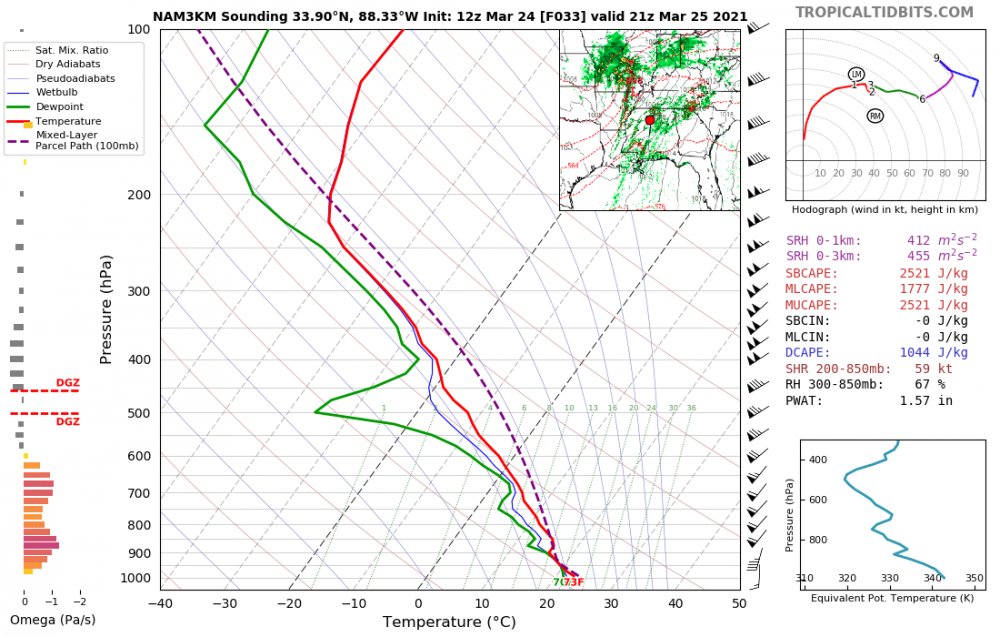
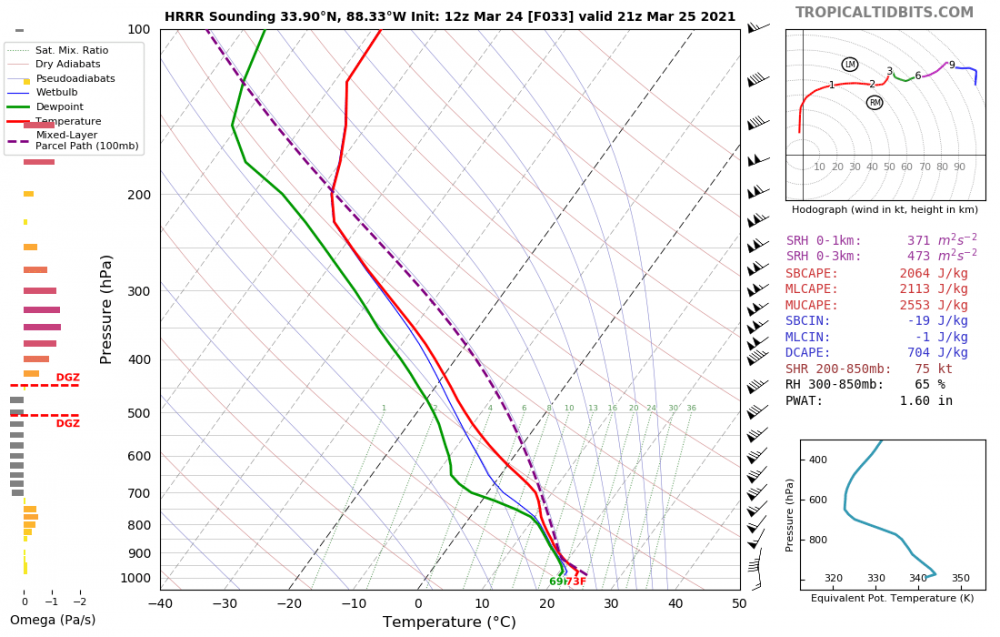
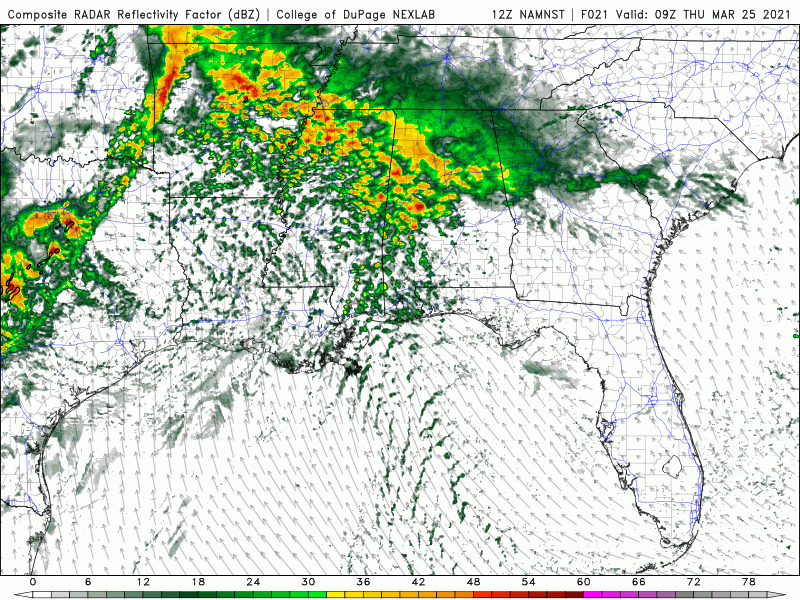
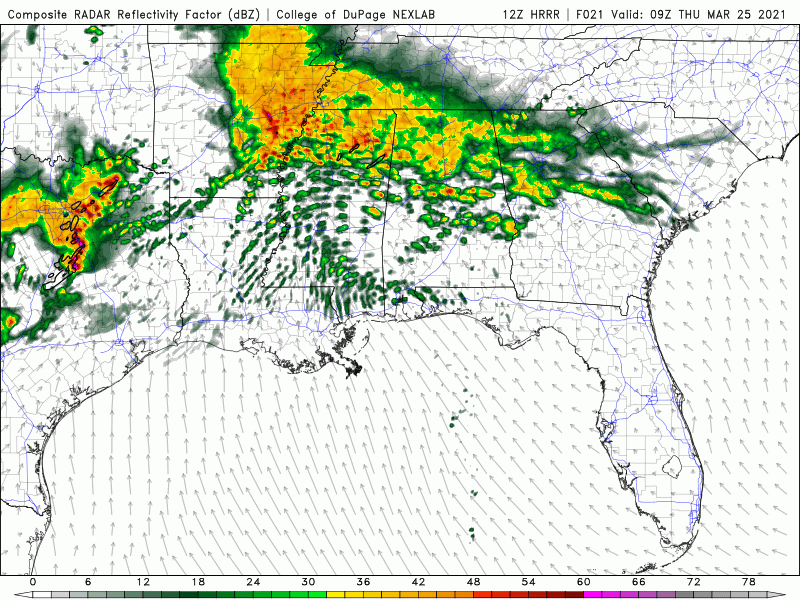
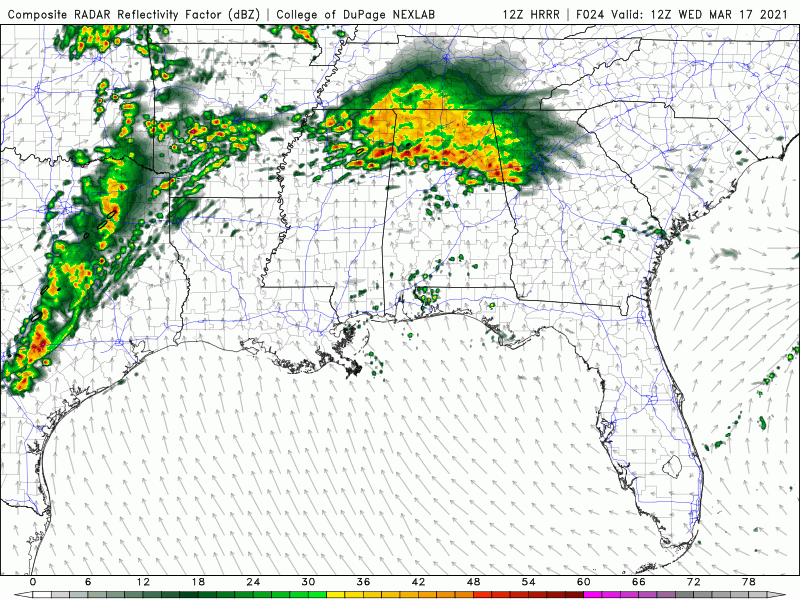
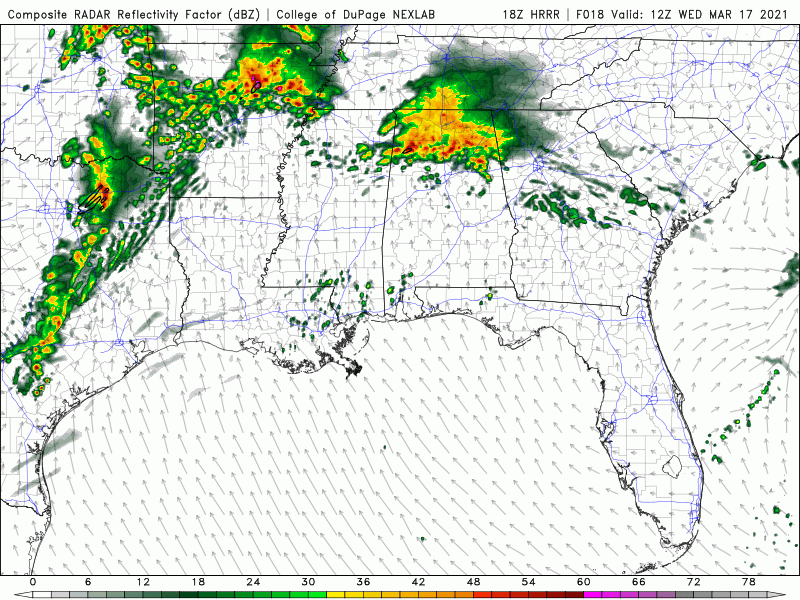
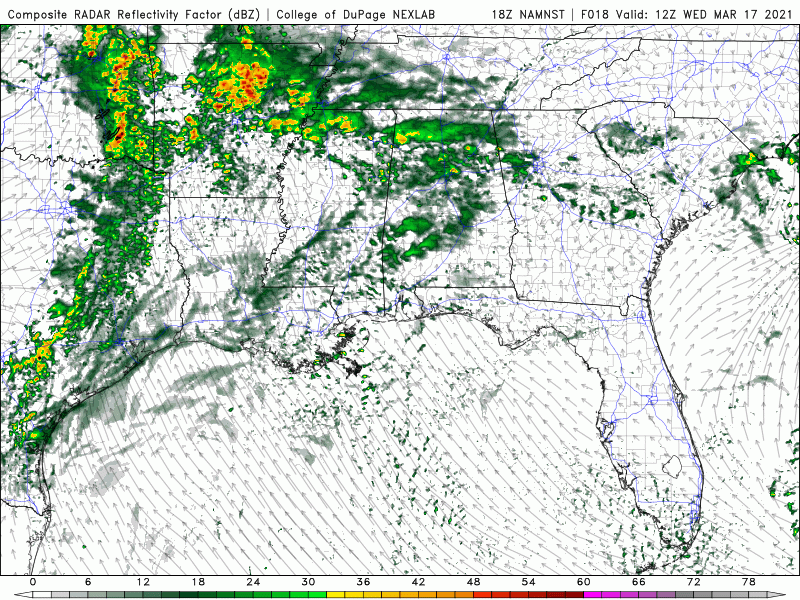
Severe Event March 25th 2021
in Southeastern States
Posted
I actually think it might make a huge difference. The HRRR is blowing a big hole in the low-level instability beneath the region of widespread convection, which is going to put a tamper on discrete updrafts. Furthermore, this sort of convective evolution will limit destabilization further north. While I feel confident that there will be tornadoes somewhere, the 00 UTC HRRR scenario is a show stopper in terms of a historic outbreak. Lets hope this pans out.
Given that this earlier convective blowup is consistent with the euro and some of the other CAMS, i'm inclined to believe it moreso than the crazy runs earlier today. It's also (for the most part) more in line with how these events typically evolve in the SEUS.